New Evidence of MIS 3 Relative Sea Level Changes from the Messina Strait, Calabria (Italy)
Abstract
:1. Introduction
1.1. MIS 3 Sea Level Historical Background
1.2. Regional Setting
1.3. Study Area
2. Previous Studies on MIS 3
2.1. MIS3 in the Global Context
2.2. A Mediterranean MIS3 Perspective
3. The Cannitello Site
3.1. Geological-Paleontological Description
3.2. Sampling and Radiocarbon Analyses
4. GIA Modelling
4.1. Model Setting
- δ-18O-dependent ice sheet models:
- 2.
- δ-18O-independent ice sheet models:
4.2. Numerical GIA Predictions
5. Discussion
6. Conclusions
Author Contributions
Funding
Institutional Review Board Statement
Informed Consent Statement
Conflicts of Interest
Abbreviations/Acronyms
| MIS | Marine Isotope Stage |
| CA | Calabrian Arc |
| MS | Mediterranean Sea |
| MSL | Mean Sea Level |
| AMS | Accelerator Mass Spectrometry |
| GIA | Glacial and hydro Isostatic Adjustment |
| RSL | Relative Sea Level |
| SLE | Sea Level Equation |
| UM | Upper Mantle |
| LUM | Lower Upper Mantle |
| TZ | Transition Zone |
| LM | Lower Mantle |
| BP | Before Present |
| DWBAH | the acronym of a submerged flowstone |
References
- Jonkers, L.; Brummer, G.-J.A.; Peeters, F.J.C.; van Aken, H.M.; de Jong, M.F. Seasonal stratification, shell flux, and oxygen isotope dynamics of left-coiling N. pachyderma and T. quinqueloba in the western subpolar North Atlantic. Paleoceanography 2010, 25, PA2204. [Google Scholar] [CrossRef] [Green Version]
- Siddall, M.; Rohling, E.J.; Thompson, W.G.; Waelbroeck, C. Marine Isotope Stage 3 Sea Level Fluctuations: Data Synthesis and New Outlook. Rev. Geophys. 2008, 46. [Google Scholar] [CrossRef]
- Imbrie, J.; Hays, J.; Martinson, D.; McIntyre, A.; Mix, A.; Morley, J.; Pisias, N.; Prell, W.; Shackleton, N. The Orbital Theory of Pleistocene Climate: Support from a Revised Chronology of the Marine Delta 18O Record. In Milankovitch and Climate, Part 1; D. Reidel Publishing: Dordrecht, The Netherlands, 1984; pp. 269–305. [Google Scholar]
- Rodriguez, A.; Anderson, J.; Banfield, L.; Taviani, M.; Abdulah, K.; Snow, J. Identification of a −15 m Wisconsin Shoreline on the Texas Inner Continental Shelf. Palaeogeogr. Palaeoclimatol. Palaeoecol. 2000, 158, 25–43. [Google Scholar] [CrossRef]
- Waelbroeck, C.; Labeyrie, L.; Michel, E.; Duplessy, J.C.; McManus, J.F.; Lambeck, K.; Balbon, E.; Labracherie, M. Sea-Level and Deep Water Temperature Changes Derived from Benthic Foraminifera Isotopic Records. Quat. Sci. Rev. 2002, 21, 295–305. [Google Scholar] [CrossRef]
- Siddall, M.; Rohling, E.J.; Almogi-Labin, A.; Hemleben, C.; Meischner, D.; Schmelzer, I.; Smeed, D.A. Sea-Level Fluctuations during the Last Glacial Cycle. Nature 2003, 423, 853–858. [Google Scholar] [CrossRef] [PubMed]
- Antonioli, F. Sea Level Change in Italy until 400 Ka: Comparing Global Sea Level Curves with Observed Data. Alp. Mediterr. Quat. 2011, 24, 11–13. [Google Scholar]
- Lambeck, K.; Yokoyama, Y.; Purcell, T. Into and out of the Last Glacial Maximum: Sea-Level Change during Oxygen Isotope Stages 3 and 2. Quat. Sci. Rev. 2002, 21, 343–360. [Google Scholar] [CrossRef]
- Chappell, J. Sea Level Changes Forced Ice Breakouts in the Last Glacial Cycle: New Results from Coral Terraces. Quat. Sci. Rev. 2002, 21, 1229–1240. [Google Scholar] [CrossRef]
- Voelker, A.H.L. Global Distribution of Centennial-Scale Records for Marine Isotope Stage (MIS) 3: A Database. Quat. Sci. Rev. 2002, 21, 1185–1212. [Google Scholar] [CrossRef]
- Kjellström, E.; Brandefelt, J.; Näslund, J.-O.; SMITH, B.; Strandberg, G.; Voelker, A.; Wohlfarth, B. Simulated Climate Conditions in Europe during the Marine Isotope Stage 3 Stadial. Boreas 2010, 39, 436–456. [Google Scholar] [CrossRef]
- Sokołowski, R.J.; Janowski, Ł.; Hrynowiecka, A.; Molodkov, A. Evolution of Fluvial System during the Pleistocene Warm Stage (Marine Isotope Stage 7)—A Case Study from the Błądzikowo Formation, N Poland. Quat. Int. 2019, 501, 109–119. [Google Scholar] [CrossRef]
- Zaretskaya, N.E.; Korsakova, O.P.; Panin, A.V. Marine Isotopic Stage 3 in Northeastern Europe: Geochronology and Events. Russ. Geol. Geophys. 2019, 60, 911–925. [Google Scholar] [CrossRef]
- Peeters, J.; Busschers, F.S.; Stouthamer, E. Fluvial Evolution of the Rhine during the Last Interglacial-Glacial Cycle in the Southern North Sea Basin: A Review and Look Forward. Quat. Int. 2015, 357, 176–188. [Google Scholar] [CrossRef]
- Monaco, C.; Barreca, G.; Stefano, A.D. Quaternary Marine Terraces and Fault Activity in the Northern Mainland Sectors of the Messina Strait (Southern Italy). Ital. J. Geosci. 2017, 136, 337–346. [Google Scholar] [CrossRef]
- Wortel, M.J.R.; Spakman, W. Subduction and Slab Detachment in the Mediterranean-Carpathian Region. Science 2000, 290, 1910–1917. [Google Scholar] [CrossRef]
- Piromallo, C.; Morelli, A. P Wave Tomography of the Mantle under the Alpine-Mediterranean Area. J. Geophys. Res. Solid Earth 2003, 108. [Google Scholar] [CrossRef]
- Chiarabba, C.; De Gori, P.; Speranza, F. The Southern Tyrrhenian Subduction Zone: Deep Geometry, Magmatism and Plio-Pleistocene Evolution. Earth Planet. Sci. Lett. 2008, 268, 408–423. [Google Scholar] [CrossRef]
- Scarfi, L.; Barberi, G.; Barreca, G.; Cannavò, F.; Koulakov, I.; Patanè, D. Slab Narrowing in the Central Mediterranean: The Calabro-Ionian Subduction Zone as Imaged by High Resolution Seismic Tomography. Sci. Rep. 2018, 8, 5178. [Google Scholar] [CrossRef] [Green Version]
- Carminati, E.; Doglioni, C. Europe: Mediterranean Tectonics. In Encyclopedia of Geology; Academic Press: Cambridge, MA, USA, 2004; pp. 135–146. [Google Scholar]
- Faccenna, C.; Funiciello, F.; Civetta, L.; D’Antonio, M.; Moroni, M.; Piromallo, C. Slab Disruption, Mantle Circulation, and the Opening of the Tyrrhenian Basins. In Cenozoic Volcanism in the Mediterranean Area; GSA Special Papers; Geological Society of America: Boulder, CO, USA, 2007; Volume 418, p. 153. [Google Scholar] [CrossRef] [Green Version]
- Faccenna, C.; Molin, P.; Orecchio, B.; Olivetti, V.; Bellier, O.; Funiciello, F.; Minelli, L.; Piromallo, C.; Billi, A. Topography of the Calabria Subduction Zone (Southern Italy): Clues for the Origin of Mt. Etna. Tectonics 2011, 30. [Google Scholar] [CrossRef]
- Corradino, C.; Ganci, G.; Cappello, A.; Bilotta, G.; Calvari, S.; Del Negro, C. Recognizing Eruptions of Mount Etna through Machine Learning Using Multiperspective Infrared Images. Remote Sens. 2020, 12, 970. [Google Scholar] [CrossRef] [Green Version]
- Pepe, F.; Kanari, M.; Burrato, P.; Corradino, M.; Duarte, H.; Ferranti, L.; Monaco, C.; Sacchi, M.; Tibor, G. Active Deformation Evidence in the Offshore of Western Calabria (Southern Tyrrhenian Sea) from Ultra-Resolution Multichannel Seismic Reflection Data: Results from the Gulf of Sant’Eufemia. In Proceedings of the EGU General Assembly 2020, Online, 4–8 May 2020. [Google Scholar]
- Westaway, R. Quaternary Uplift of Southern Italy. J. Geophys. Res. Solid Earth 1993, 98, 21741–21772. [Google Scholar] [CrossRef]
- Miyauchi, T.; Dai Pra, G.; Sylos Labini, S. Geochronology of Pleistocene Marine Terrace and Regional Tectonics in the Tyrrhenian Coast of South Calabria, Italy. Quaternario 1994, 7, 17–34. [Google Scholar]
- Ferranti, L.; Monaco, C.; Antonioli, F.; Maschio, L.; Kershaw, S.; Verrubbi, V. The Contribution of Regional Uplift and Coseismic Slip to the Vertical Crustal Motion in the Messina Straits, Southern Italy: Evidence from Raised Late Holocene Shorelines. J. Geophys. Res. Solid Earth 2007, 112. [Google Scholar] [CrossRef] [Green Version]
- Ferranti, L.; Monaco, C.; Morelli, D.; Antonioli, F.; Maschio, L. Holocene Activity of the Scilla Fault, Southern Calabria: Insights from Coastal Morphological and Structural Investigations. Tectonophysics 2008, 453, 74–93. [Google Scholar] [CrossRef]
- Ferranti, L.; Antonioli, F.; Anzidei, M.; Monaco, C.; Stocchi, P. The Timescale and Spatial Extent of Vertical Tectonic Motions in Italy: Insights from Relative Sea-Level Changes Studies. J. Virtual Explor. 2010, 36. [Google Scholar] [CrossRef]
- Ferranti, L.; Antonioli, F.; Monaco, C.; Scicchitano, G.; Spampinato, C.R. Uplifted Late Holocene Shorelines along the Coasts of the Calabrian Arc: Geodynamic and Seismotectonic Implications. Ital. J. Geosci. 2017, 136, 454–470. [Google Scholar] [CrossRef]
- Roberts, G.; Meschis, M.; Houghton, S.; Underwood, C.; Briant, R. The Implications of Revised Quaternary Palaeoshoreline Chronologies for the Rates of Active Extension and Uplift in the Upper Plate of Subduction Zones. Quat. Sci. Rev. 2013, 78, 169–187. [Google Scholar] [CrossRef]
- Pepe, F.; Bertotti, G.; Ferranti, L.; Sacchi, M.; Collura, A.; Passaro, S.; Sulli, A. Pattern and Rate of Post-20 Ka Vertical Tectonic Motion around the Capo Vaticano Promontory (W Calabria, Italy) Based on Offshore Geomorphological Indicators. Quat. Int. 2014, 332, 85–98. [Google Scholar] [CrossRef] [Green Version]
- Jacques, E.; Monaco, C.; Tapponnier, P.; Tortorici, L.; Winter, T. Faulting and Earthquake Triggering during the 1783 Calabria Seismic Sequence. Geophys. J. Int. 2001, 147, 499–516. [Google Scholar] [CrossRef] [Green Version]
- D’Agostino, N.; Selvaggi, G. Crustal Motion along the Eurasia-Nubia Plate Boundary in the Calabrian Arc and Sicily and Active Extension in the Messina Straits from GPS Measurements. J. Geophys. Res. Solid Earth 2004, 109. [Google Scholar] [CrossRef]
- Palano, M.; Ferranti, L.; Monaco, C.; Mattia, M.; Aloisi, M.; Bruno, V.; Cannavò, F.; Siligato, G. GPS Velocity and Strain Fields in Sicily and Southern Calabria, Italy: Updated Geodetic Constraints on Tectonic Block Interaction in the Central Mediterranean. J. Geophys. Res. Solid Earth 2012, 117. [Google Scholar] [CrossRef] [Green Version]
- Monaco, C.; Tortorici, L. Active Faulting in the Calabrian Arc and Eastern Sicily. J. Geodyn. 2000, 29, 407–424. [Google Scholar] [CrossRef]
- Barreca, G.; Gross, F.; Scarfì, L.; Aloisi, M.; Monaco, C.; Krastel, S. The Strait of Messina: Seismotectonics and the Source of the 1908 Earthquake. Earth-Sci. Rev. 2021, 218, 103685. [Google Scholar] [CrossRef]
- Chiarabba, C.; Jovane, L.; Di Stefano, R. A New View of Italian Seismicity Using 20 Years of Instrumental Recordings. Tectonophysics 2005, 395, 251–268. [Google Scholar] [CrossRef]
- Tortorici, L.; Monaco, C.; Tansi, C.; Cocina, O. Recent and Active Tectonics in the Calabrian Arc (Southern Italy). Tectonophysics 1995, 243, 37–55. [Google Scholar] [CrossRef]
- Aloisi, M.; Bruno, V.; Cannavò, F.; Ferranti, L.; Mattia, M.; Monaco, C.; Palano, M. Are the Source Models of the M 7.1 1908 Messina Straits Earthquake Reliable? Insights from a Novel Inversion and a Sensitivity Analysis of Levelling Data. Geophys. J. Int. 2013, 192, 1025–1041. [Google Scholar] [CrossRef] [Green Version]
- Lombardo, G. Studio Stratigrafico Del Plio-Pleistocene Del Bacino Di Reggio Calabria. Atti Acc. Gioenia Sci. Nat. Catania 1980, 12, 233–298. [Google Scholar]
- Barrier, P. Evolution Paléogéographique du Détroit de Messine au Pliocéne et au Pléistocène. G. Geol. 1996, 3, 7–24. [Google Scholar]
- Monaco, C.; Tortorici, L.; Nicolich, R.; Cernobori, L.; Costa, M. From Collisional to Rifted Basins: An Example from the Southern Calabrian Arc (Italy). Tectonophysics 1996, 266, 233–249. [Google Scholar] [CrossRef]
- Dumas, B.; Gueremy, P.; Lhenaf, R.; Raffy, J. Reliéf et Néotectonique de La Facade Orientale Du Détroit de Messine (Calabre, Italie). Travaux RCP 1978, 461, 105–125. [Google Scholar]
- Dumas, B.; Gueremy, P.; Lhenaf, R.; Raffy, J. Rates of Uplift as Shown by Raised Quaternary Shorelines in Southern Calabria (Italy). Z. Geomorphol. 1987, 63, 119–132. [Google Scholar]
- Ghisetti, F. Upper Pliocene-Pleistocene Uplift Rates as Indicators of Neotectonic Pattern: An Example from Southern Calabria (Italy). Z. Geomorphol. Suppl. 1981, 40, 93–118. [Google Scholar]
- Ghisetti, F. L’evoluzione Strutturale Del Bacino Plio-Pleistocenico Di Reggio Calabria Nel Quadro Geodinamico Dell’Arco Calabro. Boll. Geol. Ital. 1981, 100, 433–466. [Google Scholar]
- Ghisetti, F. Fault Parameters in the Messina Strait (Southern Italy) and Relations with the Seismogenic Source. Tectonophysics 1992, 210, 117–133. [Google Scholar] [CrossRef]
- Pirrotta, C.; Barbano, M.; Monaco, C. Evidence of Active Tectonics in Southern Calabria (Italy) by Geomorphic Analysis: The Examples of the Catona and Petrace Rivers. Ital. J. Geosci. 2016, 135, 142–156. [Google Scholar] [CrossRef]
- Balescu, S.; Dumas, B.; Guérémy, P.; Lamothe, M.; Lhénaff, R.; Raffy, J. Thermoluminescence Dating Tests of Pleistocene Sediments from Uplifted Marine Shorelines along the Southwest Coastline of the Calabrian Peninsula (Southern Italy). Palaeogeogr. Palaeoclimatol. Palaeoecol. 1997, 130, 25–41. [Google Scholar] [CrossRef]
- Chappell, J.; Shackleton, N.J. Oxygen Isotopes and Sea Level. Nature 1986, 324, 137–140. [Google Scholar] [CrossRef]
- Bonifiglio, L. Il Tirreniano Di Bovetto e Ravagnese Presso Reggio Calabria. Quaternaria 1972, 16, 137–148. [Google Scholar]
- Dumas, B.; Raffy, J. Late Pleistocene Tectonic Activity Deduced from Uplifted Marine Terraces in Calabria, Facing the Strait of Messina. Quat. Nova 2004, 8, 79–99. [Google Scholar]
- Ruggieri, G.; Sprovieri, R. La Definizione Dello Strtotipo Del Piano Siciliano e Le Sue Conseguenze. Nat. Sicil. 1975, IV, 187–214. [Google Scholar]
- Benjamin, J.; Rovere, A.; Fontana, A.; Furlani, S.; Vacchi, M.; Inglis, R.H.; Galili, E.; Antonioli, F.; Sivan, D.; Miko, S.; et al. Late Quaternary Sea-Level Changes and Early Human Societies in the Central and Eastern Mediterranean Basin: An Interdisciplinary Review. Quat. Int. 2017, 449, 29–57. [Google Scholar] [CrossRef] [Green Version]
- Richards, D.A.; Smart, P.L.; Edwards, R.L. Maximum Sea Levels for the Last Glacial Period from U-Series Ages of Submerged Speleothems. Nature 1994, 367, 357–360. [Google Scholar] [CrossRef]
- Li, W.-X.; Lundberg, J.; Dickin, A.P.; Ford, D.C.; Schwarcz, H.P.; McNutt, R.; Williams, D. High-Precision Mass-Spectrometric Uranium-Series Dating of Cave Deposits and Implications for Palaeoclimate Studies. Nature 1989, 339, 534–536. [Google Scholar] [CrossRef]
- Lundberg, J.; Ford, D.C. Late Pleistocene Sea Level Change in the Bahamas from Mass Spectrometric U-Series Dating of Submerged Speleothem. Quat. Sci. Rev. 1994, 13, 1–14. [Google Scholar] [CrossRef]
- Antonioli, F.; Furlani, S.; Montagna, P.; Stocchi, P. The Use of Submerged Speleothems for Sea Level Studies in the Mediterranean Sea: A New Perspective Using Glacial Isostatic Adjustment (GIA). Geosciences 2021, 11, 77. [Google Scholar] [CrossRef]
- Berkman, P.A.; Andrews, J.T.; Björck, S.; Colhoun, E.A.; Emslie, S.D.; Goodwin, I.D.; Hall, B.L.; Hart, C.P.; Hirakawa, K.; Igarashi, A.; et al. Circum-Antarctic Coastal Environmental Shifts during the Late Quaternary Reflected by Emerged Marine Deposits. Antarct. Sci. 1998, 10, 345–362. [Google Scholar] [CrossRef] [Green Version]
- Taviani, M.; Anderson, J. Response of Biogenic Carbonate Factories to Ice Sheet and Ice Shelf Dynamics: A Largely Deglaciated Ross Sea since Isotope Stage 3? In Proceedings of the 7th International Symposium on Antarctic Earth Sciences, Siena, Italy, 10–15 September 1995; p. 367. [Google Scholar]
- Anderson, J.B.; Shipp, S.S. Evolution of the West Antarctic Ice Sheet. In The West Antarctic Ice Sheet: Behavior and Environments; Antarctic Research Series; Alley, R., Bindschadler, R., Eds.; American Geophysical Union: Washington, DC, USA, 2001; Volume 77, pp. 45–57. [Google Scholar]
- Pico, T.; Mitrovica, J.; Ferrier, K.; Braun, J. Global Ice Volume during MIS 3 Inferred from a Sea-Level Analysis of Sedimentary Core Records in the Yellow River Delta. Quat. Sci. Rev. 2016, 152, 72–79. [Google Scholar] [CrossRef]
- Pasini, G.; Colalongo, M.; Curzi, P.; Taviani, M. Analisi Paleoecologica Degli Ambienti Tardo-Quaternari Del Dosso Gallignani (Adriatico Centro-Meridionale) Mediante Lo Studio Paleontologico Di Carote. Boll. Soc. Paleontol. Ital. 1993, 32, 113–130. [Google Scholar]
- Jouet, G.; Berne, S.; Rabineau, M.; Bassetti, M.-A.; Bernier, P.; Dennielou, B.; Sierro, F.J.; Flores, J.A.; Taviani, M. Shoreface Migrations at the Shelf Edge and Sea-Level Changes around the Last Glacial Maximum (Gulf of Lions, NW Mediterranean). Mar. Geol. 2006, 234, 21–42. [Google Scholar] [CrossRef] [Green Version]
- Maselli, V.; Trincardi, F.; Asioli, A.; Ceregato, A.; Rizzetto, F.; Taviani, M. Delta Growth and River Valleys: The Influence of Climate and Sea Level Changes on the South Adriatic Shelf (Mediterranean Sea). Quat. Sci. Rev. 2014, 99, 146–163. [Google Scholar] [CrossRef]
- Kırcı-Elmas, E.; Nazik, N.; Kapan, S.; Meric, E.; Zor, E.S.; Kalkan, B.; Dogan, T.; Guney, A. Ponto-Caspian and Mediterranean Faunal and Floral Records of Upper Pleistocene-Holocene Sediments from the İzmit Gulf (Marmara Sea, Turkey). Acta Palaeontol. Rom. 2021, 17, 23–62. [Google Scholar] [CrossRef]
- Amorosi, A.; Colalongo, M.L.; Fusco, F.; Pasini, G.; Fiorini, F. Glacio-Eustatic Control of Continental–Shallow Marine Cyclicity from Late Quaternary Deposits of the Southeastern Po Plain, Northern Italy. Quat. Res. 1999, 52, 1–13. [Google Scholar] [CrossRef]
- Amorosi, A.; Colalongo, M.L.; Fiorini, F.; Fusco, F.; Pasini, G.; Vaiani, S.C.; Sarti, G. Palaeogeographic and Palaeoclimatic Evolution of the Po Plain from 150-Ky Core Records. Glob. Planet. Chang. 2004, 40, 55–78. [Google Scholar] [CrossRef]
- Bassetti, M.A.; Berné, S.; Jouet, G.; Taviani, M.; Dennielou, B.; Flores, J.-A.; Gaillot, A.; Gelfort, R.; Lafuerza, S.; Sultan, N. The 100-Ka and Rapid Sea Level Changes Recorded by Prograding Shelf Sand Bodies in the Gulf of Lions (Western Mediterranean Sea). Geochem. Geophys. Geosystems 2008, 9. [Google Scholar] [CrossRef] [Green Version]
- Piva, A.; Asioli, A.; Schneider, R.R.; Trincardi, F.; Andersen, N.; Colmenero-Hidalgo, E.; Dennielou, B.; Flores, J.-A.; Vigliotti, L. Climatic Cycles as Expressed in Sediments of the PROMESS1 Borehole PRAD1-2, Central Adriatic, for the Last 370 Ka: 1. Integrated Stratigraphy. Geochem. Geophys. Geosystems 2008, 9. [Google Scholar] [CrossRef]
- Maselli, V.; Trincardi, F.; Cattaneo, A.; Ridente, D.; Asioli, A. Subsidence Pattern in the Central Adriatic and Its Influence on Sediment Architecture during the Last 400 Kyr. J. Geophys. Res. Solid Earth 2010, 115. [Google Scholar] [CrossRef] [Green Version]
- Kuhlmann, J.; Asioli, A.; Trincardi, F.; Klügel, A.; Huhn, K. Sedimentary Response to Milankovitch-Type Climatic Oscillations and Formation of Sediment Undulations: Evidence from a Shallow-Shelf Setting at Gela Basin on the Sicilian Continental Margin. Quat. Sci. Rev. 2015, 108, 76–94. [Google Scholar] [CrossRef]
- Matthews, I.P.; Trincardi, F.; Lowe, J.J.; Bourne, A.J.; MacLeod, A.; Abbott, P.M.; Andersen, N.; Asioli, A.; Blockley, S.P.E.; Lane, C.S.; et al. Developing a Robust Tephrochronological Framework for Late Quaternary Marine Records in the Southern Adriatic Sea: New Data from Core Station SA03-11. Quat. Sci. Rev. 2015, 118, 84–104. [Google Scholar] [CrossRef]
- Pellegrini, C.; Asioli, A.; Bohacs, K.M.; Drexler, T.M.; Feldman, H.R.; Sweet, M.L.; Maselli, V.; Rovere, M.; Gamberi, F.; Valle, G.D.; et al. The Late Pleistocene Po River Lowstand Wedge in the Adriatic Sea: Controls on Architecture Variability and Sediment Partitioning. Mar. Pet. Geol. 2018, 96, 16–50. [Google Scholar] [CrossRef] [Green Version]
- Campo, B.; Bruno, L.; Amorosi, A. Basin-Scale Stratigraphic Correlation of Late Pleistocene-Holocene (MIS 5e-MIS 1) Strata across the Rapidly Subsiding Po Basin (Northern Italy). Quat. Sci. Rev. 2020, 237, 106300. [Google Scholar] [CrossRef]
- Antonioli, F.; Ferranti, L. Evidenze Geomorfologiche Sommerse Nelle Aree Costiere Italiane Di Uno Stazionamento Del Livello Del Mare Ubicato a circa—20 m e Attribuito Allo Stadio 3. Quaternario 1996, 9, 205–208. [Google Scholar]
- Taviani, M. The Stage 3 Sea-Level HighsStand and Its Potential Implications on the Decoupling of Antarctic Ice Sheets. Terra Antart. Rep. 2003, 8, 159–161. [Google Scholar]
- Doğan, U.; Koçyiğit, A.; Varol, B.; Özer, İ.; Molodkov, A.; Zöhra, E. MIS 5a and MIS 3 Relatively High Sea-Level Stands on the Hatay–Samandağ Coast, Eastern Mediterranean, Turkey. Quat. Int. 2012, 262, 65–79. [Google Scholar] [CrossRef]
- Brunović, D.; Miko, S.; Hasan, O.; Papatheodorou, G.; Ilijanić, N.; Miserocchi, S.; Correggiari, A.; Geraga, M. Late Pleistocene and Holocene Paleoenvironmental Reconstruction of a Drowned Karst Isolation Basin (Lošinj Channel, NE Adriatic Sea). Palaeogeogr. Palaeoclimatol. Palaeoecol. 2020, 544, 109587. [Google Scholar] [CrossRef]
- Surić, M.; Juračić, M.; Horvatinčić, N.; Bronić, I.K. Late Pleistocene–Holocene Sea-Level Rise and the Pattern of Coastal Karst Inundation: Records from Submerged Speleothems along the Eastern Adriatic Coast (Croatia). Mar. Geol. 2005, 214, 163–175. [Google Scholar] [CrossRef]
- Bard, E.; Antonioli, F.; Silenzi, S. Sea-Level during the Penultimate Interglacial Period Based on a Submerged Stalagmite from Argentarola Cave (Italy). Earth Planet. Sci. Lett. 2002, 196, 135–146. [Google Scholar] [CrossRef]
- Dutton, A.; Bard, E.; Antonioli, F.; Esat, T.M.; Lambeck, K.; McCulloch, M.T. Phasing and Amplitude of Sea-Level and Climate Change during the Penultimate Interglacial. Nat. Geosci. 2009, 2, 355–359. [Google Scholar] [CrossRef]
- Dutton, A.; Scicchitano, G.; Monaco, C.; Desmarchelier, J.M.; Antonioli, F.; Lambeck, K.; Esat, T.M.; Fifield, L.K.; McCulloch, M.T.; Mortimer, G. Uplift Rates Defined by U-Series and 14C Ages of Serpulid-Encrusted Speleothems from Submerged Caves near Siracusa, Sicily (Italy). Quat. Geochronol. 2009, 4, 2–10. [Google Scholar] [CrossRef]
- Scicchitano, G.; Monaco, C. Karstic Caves and Submerged Paleo-Shorelines in the Coastal Area between Capo Santa Panagia and Ognina (Siracusa, South-Eastern Sicily). Alp. Mediterr. Quat. 2006, 19, 187–194. [Google Scholar]
- Ferranti, L.; Santoro, E.; Mazzella, M.E.; Monaco, C.; Morelli, D. Active Transpression in the Northern Calabria Apennines, Southern Italy. Tectonophysics 2009, 476, 226–251. [Google Scholar] [CrossRef]
- Santoro, E.; Mazzella, M.E.; Ferranti, L.; Randisi, A.; Napolitano, E.; Rittner, S.; Radtke, U. Raised Coastal Terraces along the Ionian Sea Coast of Northern Calabria, Italy, Suggest Space and Time Variability of Tectonic Uplift Rates. Quat. Int. 2009, 206, 78–101. [Google Scholar] [CrossRef]
- Santoro, E.; Ferranti, L.; Burrato, P.; Mazzella, M.E.; Monaco, C. Deformed Pleistocene Marine Terraces along the Ionian Sea Margin of Southern Italy: Unveiling Blind Fault-Related Folds Contribution to Coastal Uplift. Tectonics 2013, 32, 737–762. [Google Scholar] [CrossRef] [Green Version]
- Zander, A.; Fulling, A.; Brückner, H.; Mastronuzzi, G. OSL Dating of Upper Pleistocene Littoral Sediments: A Contribution to the Chronostratigraphy of Raised Marine Terraces Bordering the Gulf of Taranto, South Italy. Geogr. Fis. Din. Quat. 2006, 29, 33–50. [Google Scholar]
- Sauer, D.; Wagner, S.; Brückner, H.; Scarciglia, F.; Mastronuzzi, G.; Stahr, K. Soil Development on Marine Terraces near Metaponto (Gulf of Taranto, Southern Italy). Quat. Int. 2010, 222, 48–63. [Google Scholar] [CrossRef]
- Taviani, M.; Angeletti, L.; Cardone, F.; Montagna, P.; Danovaro, R. A Unique and Threatened Deep Water Coral-Bivalve Biotope New to the Mediterranean Sea Offshore the Naples Megalopolis. Sci. Rep. 2019, 9, 3411. [Google Scholar] [CrossRef] [PubMed] [Green Version]
- Calcagnile, L.; Maruccio, L.; Scrimieri, L.; delle Side, D.; Braione, E.; D’Elia, M.; Quarta, G. Development and Application of Facilities at the Centre for Applied Physics, Dating and Diagnostics (CEDAD) at the University of Salento during the Last 15 years. Nucl. Instrum. Methods Phys. Res. Sect. B Beam Interact. Mater. At. 2019, 456, 252–256. [Google Scholar] [CrossRef]
- Heaton, T.J.; Köhler, P.; Butzin, M.; Bard, E.; Reimer, R.W.; Austin, W.E.N.; Ramsey, C.B.; Grootes, P.M.; Hughen, K.A.; Kromer, B.; et al. Marine20—The Marine Radiocarbon Age Calibration Curve (0–55,000 Cal BP). Radiocarbon 2020, 62, 779–820. [Google Scholar] [CrossRef]
- Siani, G.; Paterne, M.; Arnold, M.; Bard, E.; Métivier, B.; Tisnerat, N.; Bassinot, F. Radiocarbon Reservoir Ages in the Mediterranean Sea and Black Sea. Radiocarbon 2000, 42, 271–280. [Google Scholar] [CrossRef] [Green Version]
- Peltier, W.R. GLOBAL GLACIAL ISOSTASY AND THE SURFACE OF THE ICE-AGE EARTH: The ICE-5G (VM2) Model and GRACE. Annu. Rev. Earth Planet. Sci. 2004, 32, 111–149. [Google Scholar] [CrossRef]
- Stocchi, P.; Spada, G. Influence of Glacial Isostatic Adjustment upon Current Sea Level Variations in the Mediterranean. Tectonophysics 2009, 474, 56–68. [Google Scholar] [CrossRef]
- Lisiecki, L.E.; Raymo, M.E. A Pliocene-Pleistocene Stack of 57 Globally Distributed Benthic Δ18O Records. Paleoceanography 2005, 20. [Google Scholar] [CrossRef] [Green Version]
- Argus, D.F.; Peltier, W.R.; Drummond, R.; Moore, A.W. The Antarctica Component of Postglacial Rebound Model ICE-6G_C (VM5a) Based on GPS Positioning, Exposure Age Dating of Ice Thicknesses, and Relative Sea Level Histories. Geophys. J. Int. 2014, 198, 537–563. [Google Scholar] [CrossRef]
- de Boer, B.; Stocchi, P.; Whitehouse, P.L.; van de Wal, R.S.W. Current State and Future Perspectives on Coupled Ice-Sheet—Sea-Level Modelling. Quat. Sci. Rev. 2017, 169, 13–28. [Google Scholar] [CrossRef] [Green Version]
- de Boer, B.; Stocchi, P.; van de Wal, R.S.W. A Fully Coupled 3-D Ice-Sheet–Sea-Level Model: Algorithm and Applications. Geosci. Model Dev. 2014, 7, 2141–2156. [Google Scholar] [CrossRef] [Green Version]
- Gowan, E.J.; Zhang, X.; Khosravi, S.; Rovere, A.; Stocchi, P.; Hughes, A.L.C.; Gyllencreutz, R.; Mangerud, J.; Svendsen, J.-I.; Lohmann, G. A New Global Ice Sheet Reconstruction for the Past 80 000 Years. Nat. Commun. 2021, 12, 1199. [Google Scholar] [CrossRef] [PubMed]
- Antonioli, F.; Furlani, S.; Montagna, P.; Stocchi, P.; Calcagnile, L.; Quarta, G.; Cecchinel, J.; Presti, V.L.; Morticelli, M.G.; Martin, F.F.; et al. Submerged Speleothems and Sea Level Reconstructions: A Global Overview and New Results from the Mediterranean Sea. Water 2021, 13, 1663. [Google Scholar] [CrossRef]
- Antonioli, F.; Ferranti, L.; Stocchi, P.; Deiana, G.; Lo Presti, V.; Furlani, S.; Marino, C.; Orru, P.; Scicchitano, G.; Trainito, E.; et al. Morphometry and Elevation of the Last Interglacial Tidal Notches in Tectonically Stable Coasts of the Mediterranean Sea. Earth-Sci. Rev. 2018, 185, 600–623. [Google Scholar] [CrossRef]
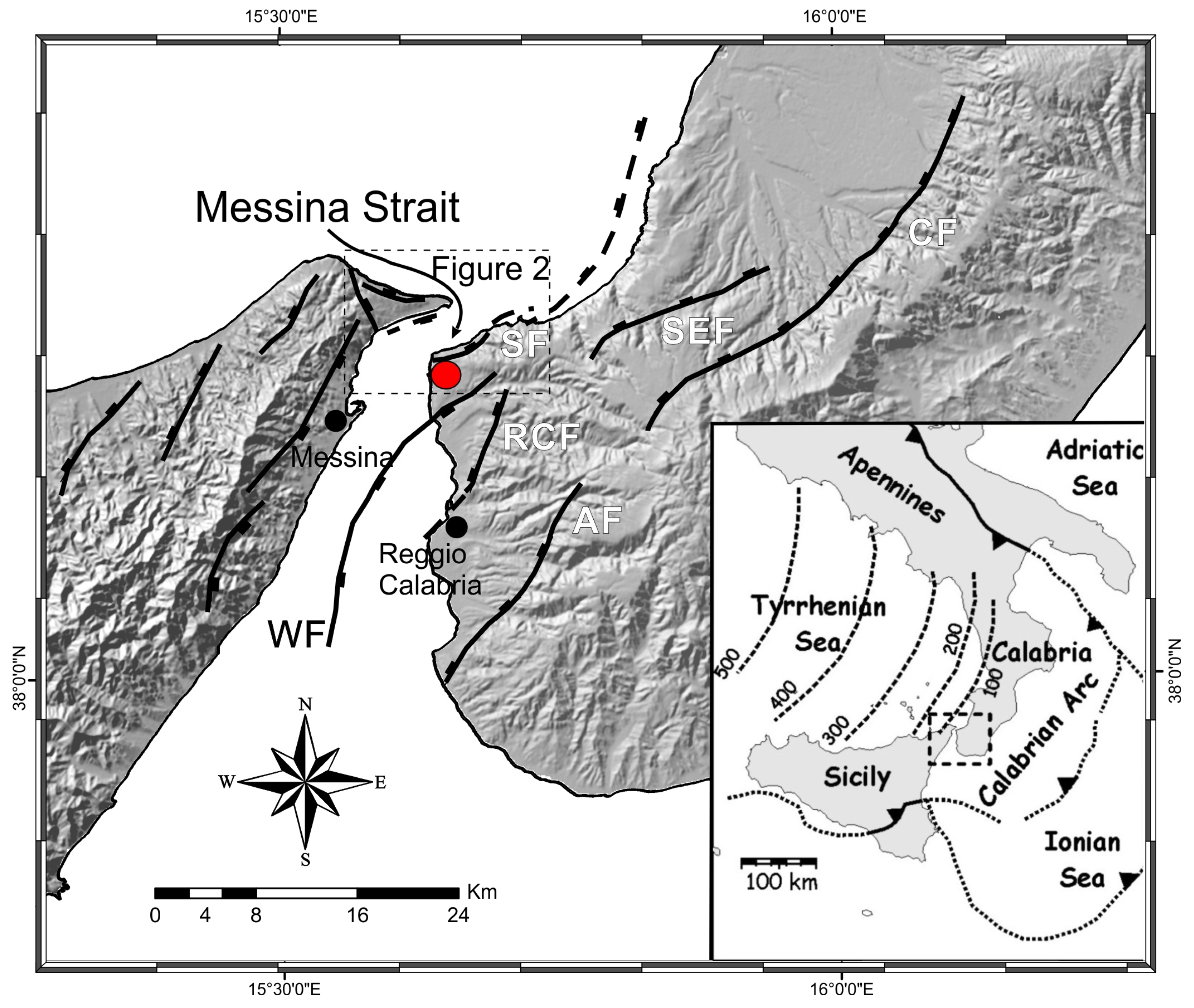
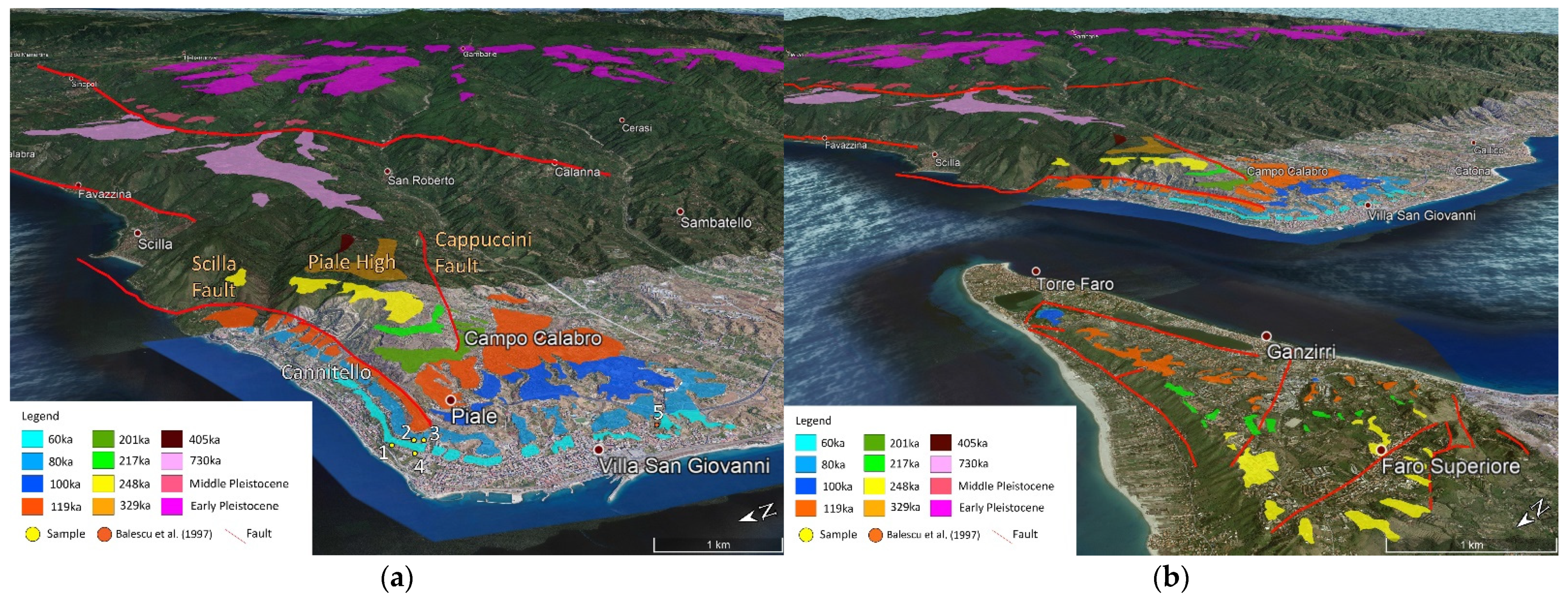
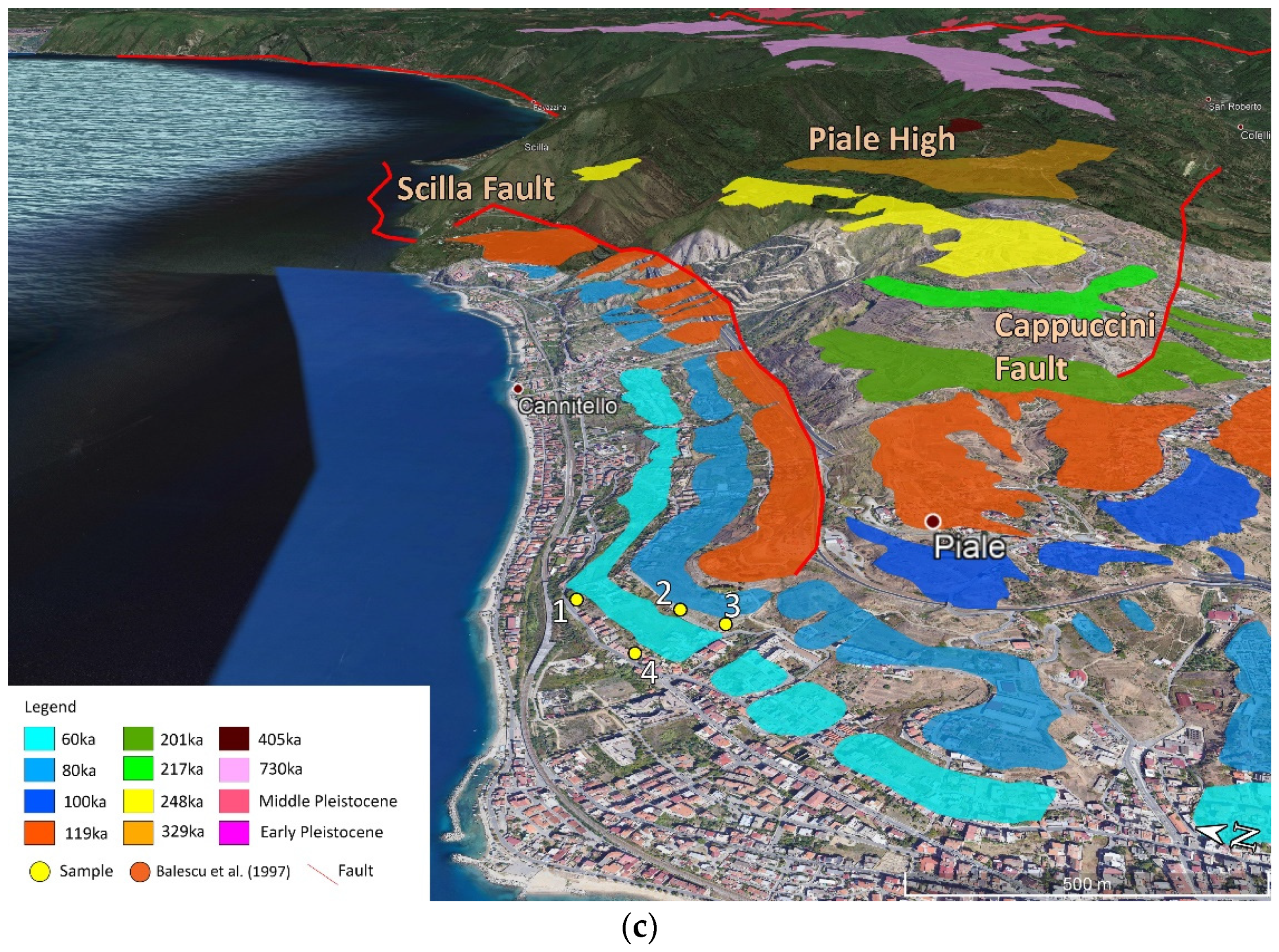
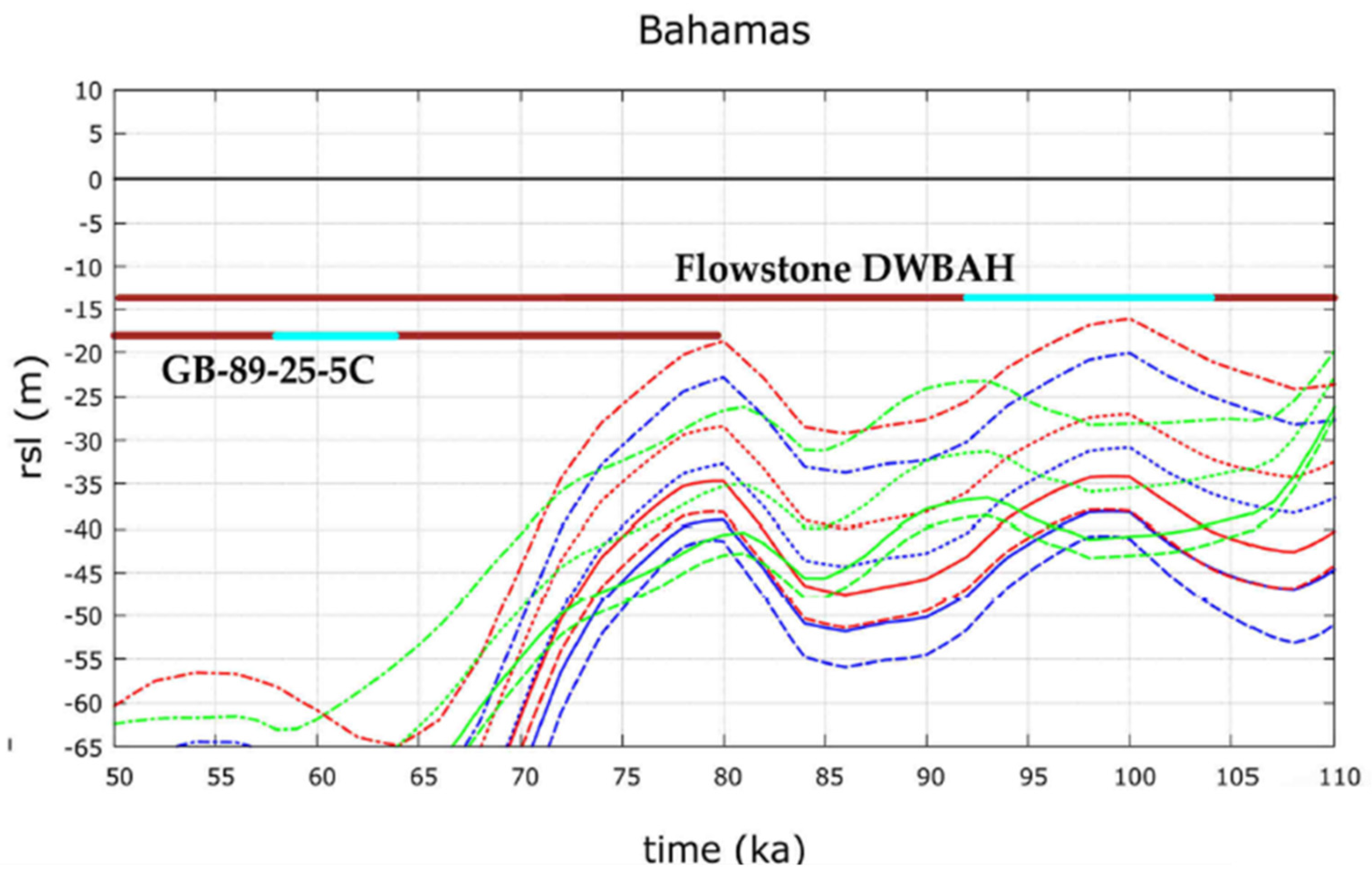
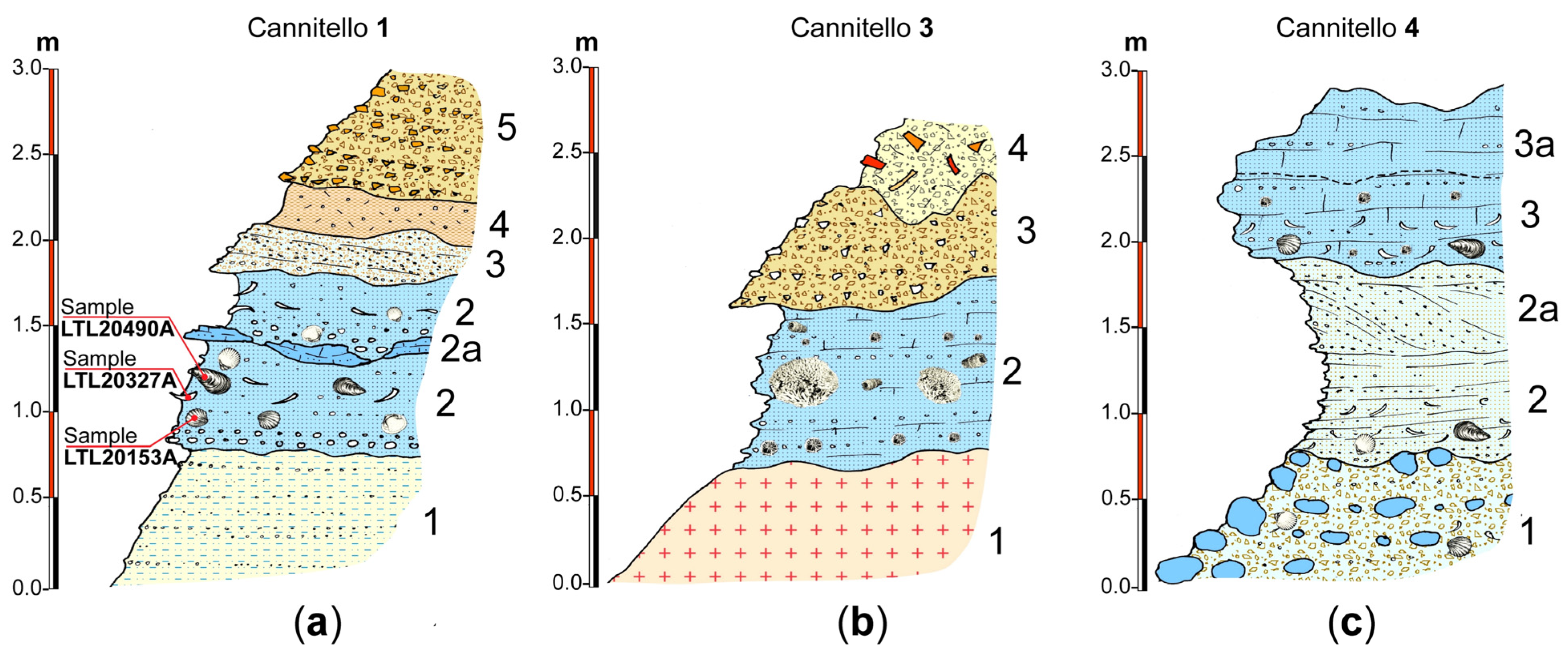

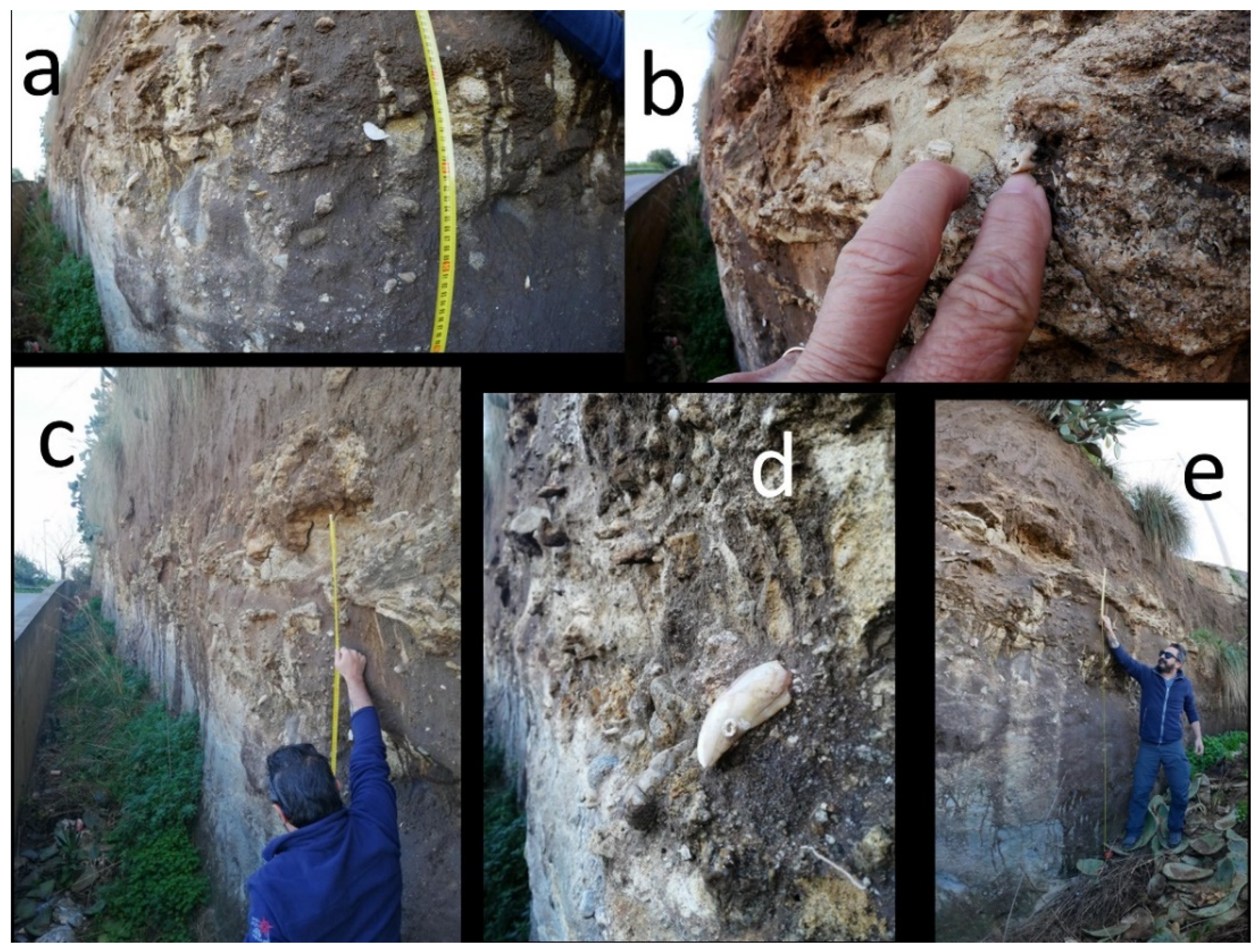
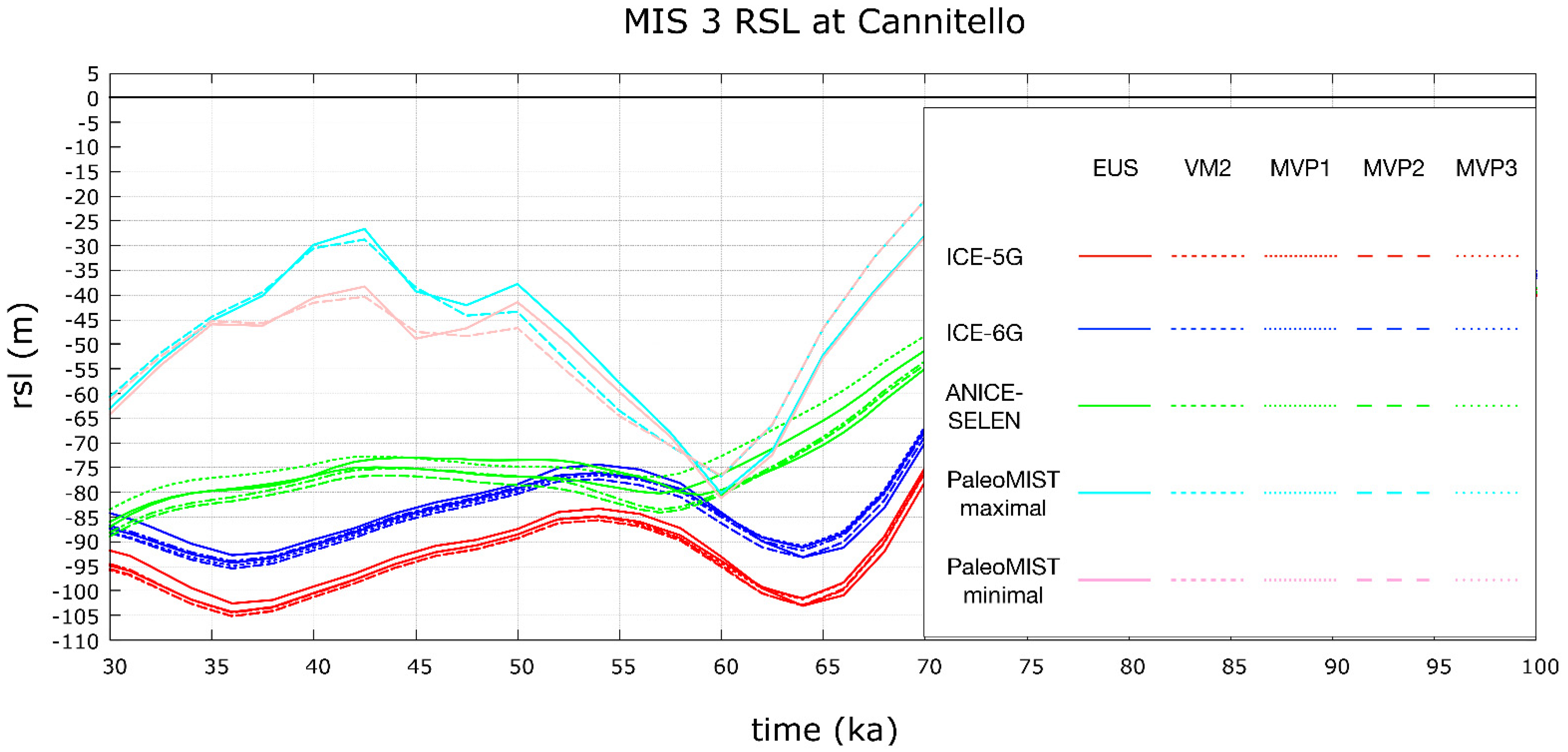
| Site Number | Latitude | Longitude | GPS Altitude m | Google Earth Altitude m |
|---|---|---|---|---|
| CANNITELLO 1 | 38.232280 N | 15.644851 E | 28.382 | 30 |
| CANNITELLO 2 | 38.230440 N | 15.644630 E | 57.201 | 57 |
| CANNITELLO 3 | 38.229399 N | 15.643769 E | 48.122 | 47 |
| CANNITELLO 4 | 38.230805 N | 15.642728 E | 27.282 | 28 |
| Sample | Radiocarbon Age Years (BP) | Age Years Cal BP 1sigma | δ13C (‰) | Fossil | Altitude Satellite m |
|---|---|---|---|---|---|
| LTL20153A | >48,000 | 2.5 ± 0.2 | Mytilus | 28.3 ± 0.2 | |
| LTL20327A | 40,887 ± 320 | 43,152 ± 304 | 4.2 ± 0.4 | Gastropod | 28.3 ± 0.2 |
| LTL20490A | 40,828 ± 300 | 43,092 ± 273 | 0.3 ± 0.2 | Arca noae | 29.3 ± 0.2 |
| VM2 | LT (km) | UM (×1021 Pa·s) | LUM (×1021 Pa·s) | TZ (×1021 Pa·s) | LM (×1021 Pa·s) |
|---|---|---|---|---|---|
| 90 | 0.67 | 0.44 | 0.46 | 2.53 |
| MVPs | LT (km) | UM (×1021 Pa·s) | TZ (×1021 Pa·s) | LM (×1021 Pa·s) |
|---|---|---|---|---|
| MVP1 | 100 | 1 | 1 | 2 |
| MVP2 | 100 | 0.5 | 0.5 | 5 |
| MVP3 | 100 | 0.25 | 0.5 | 10 |
| 1 Observed Elevation of Terraces Inner Margins or Fossils/Infra/Circalittoral Raised Deposits * m | 2 Marine Isotopic Stage (MIS) | 3 Age (ka) | 4 Eustatic Sea Level (m) | 5 Uplift Rate mm\y | 6 Mean Uplift Rate mm\y |
|---|---|---|---|---|---|
| * 28 1 | 3.1 | 43.1 1 | −34 1 | 1.4–1.7 | |
| 45 2 | 3.3 | 64 2 | −48 2 | 1.4 | |
| 85 2 | 5.1 | 81 3 | −16 3 | 1.2 | 1.3 |
| 120 2 | 5.3 | 101 3 | −19 4 | 1.4 | |
| 165 2 | 5.5 | 119 4 | +8.35 4 | 1.3 | |
| 205 2 | 7.1 | 201.5 5 | −16 4 | 1.3 | |
| 285 2 | 7.3 | 217.2 5 | −17.5 4 | 1.1 | |
| 345 2 | 7.5 | 248.9 5 | −13 4 | 1.2 | |
| 415 2 | 9 | 329 6 | +4 4 | 1.3 | |
| 520 3 | 11 | 405 6 | +5 4 | 1.2 | |
| 680 3 | 19 | 760 6 | −5 4 | 0.9 | 0.9 |
Publisher’s Note: MDPI stays neutral with regard to jurisdictional claims in published maps and institutional affiliations. |
© 2021 by the authors. Licensee MDPI, Basel, Switzerland. This article is an open access article distributed under the terms and conditions of the Creative Commons Attribution (CC BY) license (https://creativecommons.org/licenses/by/4.0/).
Share and Cite
Antonioli, F.; Calcagnile, L.; Ferranti, L.; Mastronuzzi, G.; Monaco, C.; Orrù, P.; Quarta, G.; Pepe, F.; Scardino, G.; Scicchitano, G.; et al. New Evidence of MIS 3 Relative Sea Level Changes from the Messina Strait, Calabria (Italy). Water 2021, 13, 2647. https://doi.org/10.3390/w13192647
Antonioli F, Calcagnile L, Ferranti L, Mastronuzzi G, Monaco C, Orrù P, Quarta G, Pepe F, Scardino G, Scicchitano G, et al. New Evidence of MIS 3 Relative Sea Level Changes from the Messina Strait, Calabria (Italy). Water. 2021; 13(19):2647. https://doi.org/10.3390/w13192647
Chicago/Turabian StyleAntonioli, Fabrizio, Lucio Calcagnile, Luigi Ferranti, Giuseppe Mastronuzzi, Carmelo Monaco, Paolo Orrù, Gianluca Quarta, Fabrizio Pepe, Giovanni Scardino, Giovanni Scicchitano, and et al. 2021. "New Evidence of MIS 3 Relative Sea Level Changes from the Messina Strait, Calabria (Italy)" Water 13, no. 19: 2647. https://doi.org/10.3390/w13192647
APA StyleAntonioli, F., Calcagnile, L., Ferranti, L., Mastronuzzi, G., Monaco, C., Orrù, P., Quarta, G., Pepe, F., Scardino, G., Scicchitano, G., Stocchi, P., & Taviani, M. (2021). New Evidence of MIS 3 Relative Sea Level Changes from the Messina Strait, Calabria (Italy). Water, 13(19), 2647. https://doi.org/10.3390/w13192647














